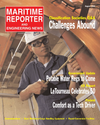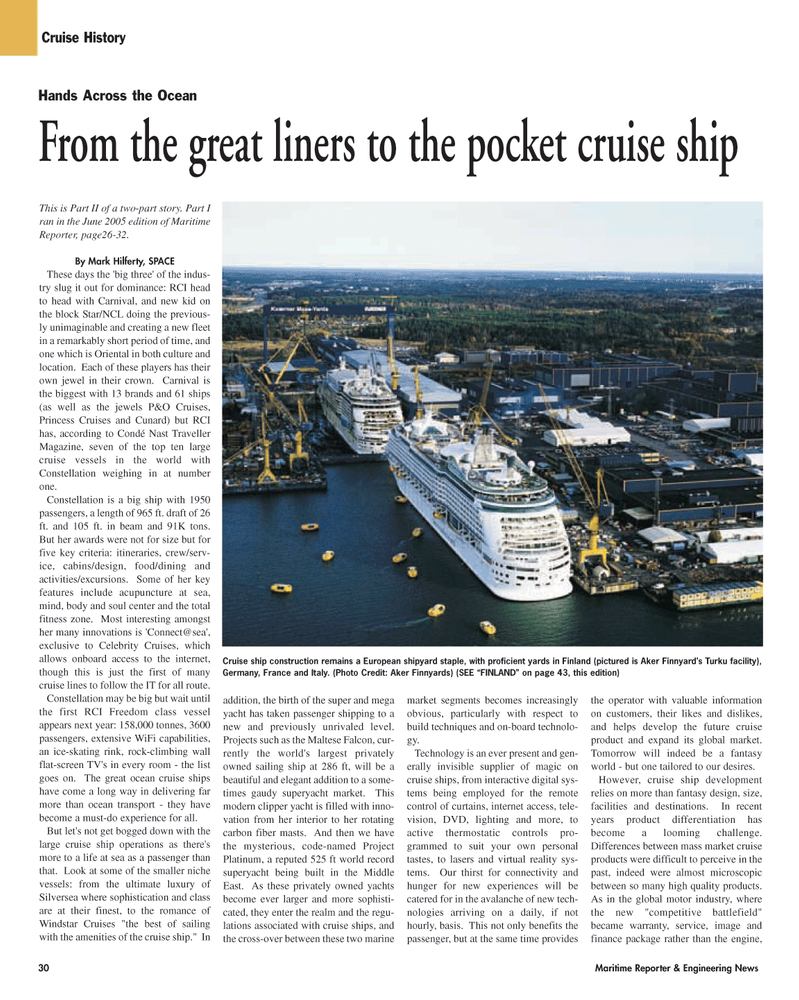
Page 30: of Maritime Reporter Magazine (August 2005)
AWO Edition: Inland & Offshore Waterways
Read this page in Pdf, Flash or Html5 edition of August 2005 Maritime Reporter Magazine
30 Maritime Reporter & Engineering News
This is Part II of a two-part story. Part I ran in the June 2005 edition of Maritime
Reporter, page26-32.
By Mark Hilferty, SPACE
These days the 'big three' of the indus- try slug it out for dominance: RCI head to head with Carnival, and new kid on the block Star/NCL doing the previous- ly unimaginable and creating a new fleet in a remarkably short period of time, and one which is Oriental in both culture and location. Each of these players has their own jewel in their crown. Carnival is the biggest with 13 brands and 61 ships (as well as the jewels P&O Cruises,
Princess Cruises and Cunard) but RCI has, according to Condé Nast Traveller
Magazine, seven of the top ten large cruise vessels in the world with
Constellation weighing in at number one.
Constellation is a big ship with 1950 passengers, a length of 965 ft. draft of 26 ft. and 105 ft. in beam and 91K tons.
But her awards were not for size but for five key criteria: itineraries, crew/serv- ice, cabins/design, food/dining and activities/excursions. Some of her key features include acupuncture at sea, mind, body and soul center and the total fitness zone. Most interesting amongst her many innovations is 'Connect@sea', exclusive to Celebrity Cruises, which allows onboard access to the internet, though this is just the first of many cruise lines to follow the IT for all route.
Constellation may be big but wait until the first RCI Freedom class vessel appears next year: 158,000 tonnes, 3600 passengers, extensive WiFi capabilities, an ice-skating rink, rock-climbing wall flat-screen TV's in every room - the list goes on. The great ocean cruise ships have come a long way in delivering far more than ocean transport - they have become a must-do experience for all.
But let's not get bogged down with the large cruise ship operations as there's more to a life at sea as a passenger than that. Look at some of the smaller niche vessels: from the ultimate luxury of
Silversea where sophistication and class are at their finest, to the romance of
Windstar Cruises "the best of sailing with the amenities of the cruise ship." In addition, the birth of the super and mega yacht has taken passenger shipping to a new and previously unrivaled level.
Projects such as the Maltese Falcon, cur- rently the world's largest privately owned sailing ship at 286 ft, will be a beautiful and elegant addition to a some- times gaudy superyacht market. This modern clipper yacht is filled with inno- vation from her interior to her rotating carbon fiber masts. And then we have the mysterious, code-named Project
Platinum, a reputed 525 ft world record superyacht being built in the Middle
East. As these privately owned yachts become ever larger and more sophisti- cated, they enter the realm and the regu- lations associated with cruise ships, and the cross-over between these two marine market segments becomes increasingly obvious, particularly with respect to build techniques and on-board technolo- gy.
Technology is an ever present and gen- erally invisible supplier of magic on cruise ships, from interactive digital sys- tems being employed for the remote control of curtains, internet access, tele- vision, DVD, lighting and more, to active thermostatic controls pro- grammed to suit your own personal tastes, to lasers and virtual reality sys- tems. Our thirst for connectivity and hunger for new experiences will be catered for in the avalanche of new tech- nologies arriving on a daily, if not hourly, basis. This not only benefits the passenger, but at the same time provides the operator with valuable information on customers, their likes and dislikes, and helps develop the future cruise product and expand its global market.
Tomorrow will indeed be a fantasy world - but one tailored to our desires.
However, cruise ship development relies on more than fantasy design, size, facilities and destinations. In recent years product differentiation has become a looming challenge.
Differences between mass market cruise products were difficult to perceive in the past, indeed were almost microscopic between so many high quality products.
As in the global motor industry, where the new "competitive battlefield" became warranty, service, image and finance package rather than the engine,
Cruise History
Hands Across the Ocean
From the great liners to the pocket cruise ship
Cruise ship construction remains a European shipyard staple, with proficient yards in Finland (pictured is Aker Finnyard's Turku facility),
Germany, France and Italy. (Photo Credit: Aker Finnyards) (SEE “FINLAND” on page 43, this edition)
MR AUGUST 2005 #4 (25-32).qxd 8/4/2005 6:07 PM Page 30

 29
29

 31
31
